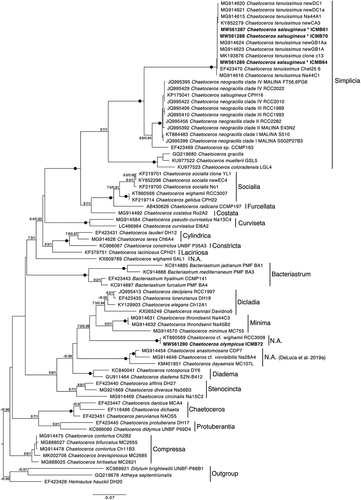Article title: Taxonomic relationship between two small-sized Chaetoceros species
(Bacillariophyta): C. tenuissimus and C. salsugineus, and comparison with C.
olympicus sp. nov. from Catalan coastal waters (NW Mediterranean)
Authors: Laura Arin, Albert Reñé, Rachele Gallisai, Diana Sarno, Esther Garcés and Marta Estrada
Journal: European Journal of Phycology
DOI: https://doi.org/10.1080/09670262.2021.1966838
This research article was first published with the following errors: Figs. 25-32 were incorrectly duplicated in place of , which was missing; was incorrectly typeset; and references to “De Luca et al., 2019a” and “De Luca et al., 2019b” were incorrectly mixed.
Table 4. Morphological characters of C. olympicus compared with two similar chain-forming species: C. tenuissimus (this study) and C. wighamii (Bosak et al., 2015).
is now correct:
Fig. 45. LSU rDNA phylogenetic tree including sequences of some Chaetoceros representatives of interest and sequences obtained in this study (in bold). Sequences of Bacteriastrum species were used as outgroup. Statistical support shown in nodes corresponds to boostrap values (%) and Bayesian posterior probability. Only values >70% and 0.95 respectively are shown and black dots represent maximum statistical support. The different phylogenetic clusters were labelled according to morphological sections proposed in De Luca et al. (2019a). N.A. = species not assigned to any existing section. *C. tenuissimus after this work, see Discussion.

is now correct:
The references to “De Luca et al., 2019a” and “De Luca et al., 2019b” are now correct throughout the text.
